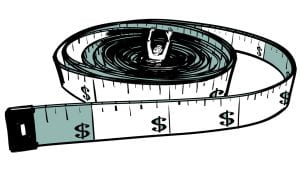Published in the Seattle Times Dec. 3, 2017
 This fall the U.S. Census Bureau brought good news when it informed us that the nation’s poverty rate had fallen from 13.2 to 12.7 percent.
This fall the U.S. Census Bureau brought good news when it informed us that the nation’s poverty rate had fallen from 13.2 to 12.7 percent.
But now more than ever, we should be suspicious of this news.
Liberals, on the other hand, point out that poverty income does not deduct families’ non-discretionary expenses such as taxes, child care and health care. Such omissions are particularly outdated when it comes to health care: In 1960, when the current poverty formula was adopted, a typical worker spent a week’s wages on health expenses. Today it takes two months.
Such inadequacies have been at the heart of longstanding debate over our poverty measure and explain why in 2010 the Census Bureau adopted an additional poverty indicator called the Supplementary Poverty Measure (SPM). The SPM addresses the above shortcomings (and others) by adjusting both the poverty threshold and the definition of income.
The Census Bureau now publishes the SPM alongside the official poverty rate. Currently the SPM counts another 4 million Americans as poor, which leads to a poverty rate of 13.9 percent — or 1.2 percentage points above the official one. This difference is the largest gap ever between these two poverty measures.
official one. This difference is the largest gap ever between these two poverty measures.
Because it uses a more reasonable threshold and deducts non-discretionary expenses from income, the SPM gives us a better estimate of the share of Americans who are poor. Meanwhile, the shortcomings of our official indicator of poverty just grow by the day.
Consider, for instance, this year’s slate of health-care proposals. Nearly every one entailed a dramatic rollback of Medicaid. One consequence would have been that millions of low-income citizens would have faced higher health-care bills. If poverty were properly measured by subtracting medically necessary expenses from income (as the SPM does), any of these proposed changes would have encouraged lawmakers to confront the immiserating consequences of each proposal.
But our official measure takes no account of the burden of health care on low-income families’ budgets. Lawmakers are thus not held accountable for any change in health policy that leaves additional households unable to make ends meet.
And for the poor, the burden of paying for health care is already excessive. One-third of poor Americans spend at least 5 percent of their earnings on out-of-pocket health expenses; one-in-five spends 10 percent. Indeed, one-fourth of those in poverty by the SPM’s standard are there because of medical expenses. Reduce enrollments in Medicaid, and millions more join them in that plight.
Our outdated way of measuring poverty dates to a period more than a half century ago when health care was a minor expense. That era is long gone. These times call for a new measure of poverty that reflects the challenges of the 21st century — challenges that include figuring out how to finance our health-care system in a way that doesn’t impoverish our fellow citizens.
